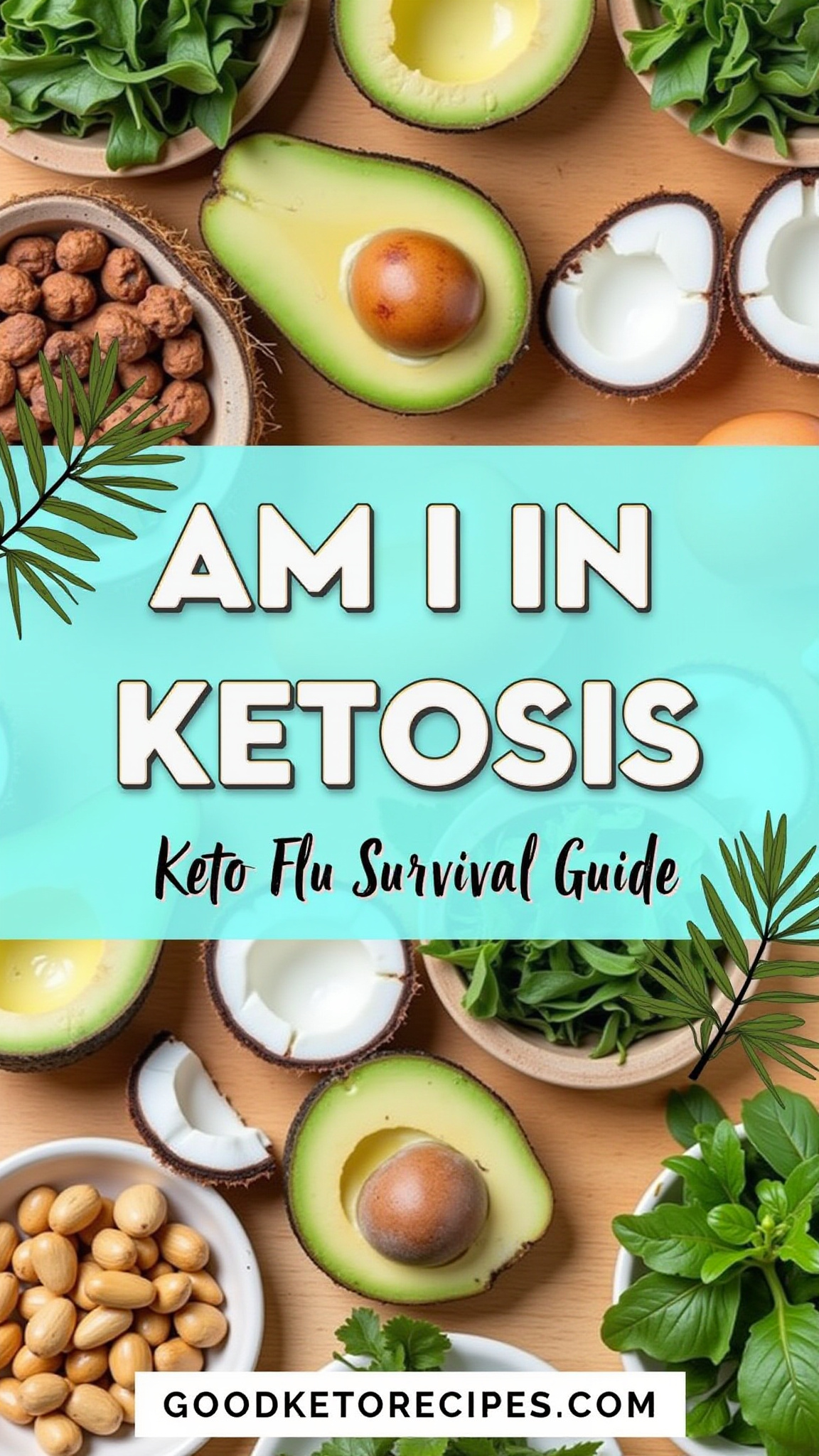Am I In Ketosis? Keto Flu Survival Guide

Ketosis is a metabolic state where your body burns fat for fuel instead of carbohydrates. Achieving ketosis has become a popular goal, particularly for those following the ketogenic diet. But how do you know if you’ve actually reached ketosis? And what about the dreaded “keto flu”? This comprehensive guide will explore the telltale signs of ketosis and provide practical strategies to avoid or minimize keto flu symptoms, ensuring a smoother transition into this fat-burning state.
How to Know You’re in Ketosis
While blood ketone meters provide the most accurate measurements, several noticeable signs and symptoms can indicate that you’re in ketosis. Here’s what to look for:
1. Increased Thirst and Frequent Urination
When carbohydrate intake is drastically reduced, your body starts using stored glycogen (glucose) for energy. Glycogen holds onto water. As your body depletes these glycogen stores, it releases this water, leading to increased urination and, consequently, increased thirst.
- Explanation: The kidneys work harder to filter out ketones, contributing to fluid loss.
- Actionable Tip: Drink plenty of water throughout the day to stay hydrated.

2. Bad Breath (Keto Breath)
One of the more distinct signs of ketosis is a fruity or acetone-like odor on your breath, often referred to as “keto breath.” This is due to the presence of acetone, a ketone body produced during fat metabolism, which is exhaled through the lungs.
- Explanation: Acetone is a byproduct of fat breakdown and is eliminated through breath and urine.
- Actionable Tip: While temporary, keto breath can be managed by:
- Drinking plenty of water.
- Brushing your teeth more frequently.
- Using sugar-free gum or mints (in moderation).
- Some find that parsley can help eliminate bad breath
3. Suppressed Appetite
Ketosis can have a significant impact on appetite. Many people report feeling less hungry when their bodies are primarily burning fat for fuel.
- Explanation: Ketones, particularly beta-hydroxybutyrate (BHB), can suppress hunger hormones like ghrelin. Additionally, the higher fat and protein content of a ketogenic diet promotes satiety.
- Actionable Tip: Listen to your body’s hunger cues. Don’t force yourself to eat if you’re not hungry.
4. Increased Energy Levels (After the Initial Adjustment)
Initially, transitioning to ketosis can cause fatigue. However, once your body becomes adapted to burning fat for fuel, many people experience sustained energy levels throughout the day.
- Explanation: Fat is a more stable and efficient fuel source than glucose, providing a steady release of energy. Unlike glucose, which can cause energy spikes and crashes, fat provides a more consistent source of fuel.
- Actionable Tip: Be patient during the initial adjustment period. Consistent adherence to the ketogenic diet will lead to more stable energy levels.
5. Changes in Sleep Patterns
Some individuals report changes in their sleep patterns when entering ketosis. These changes can range from improved sleep quality to insomnia.
- Explanation: Hormonal shifts and metabolic changes can affect sleep.
- Actionable Tip:
- Maintain a consistent sleep schedule.
- Create a relaxing bedtime routine.
- Avoid caffeine and alcohol before bed.
- Ensure your electrolyte levels are balanced.

6. Digestive Changes
Digestive changes are a common side effect when starting a ketogenic diet. Some people experience constipation, while others experience diarrhea.
- Explanation: These changes are often due to alterations in gut bacteria and fiber intake.
- Actionable Tip:
- Increase your fiber intake with low-carb vegetables like spinach, broccoli, and cauliflower.
- Consider taking a magnesium supplement, which can help with constipation.
- Ensure adequate hydration.
- Incorporate probiotic-rich foods like sauerkraut or kimchi into your diet.

7. Mental Clarity and Focus
Many people report improved mental clarity and focus when in ketosis.
- Explanation: Ketones, particularly BHB, can cross the blood-brain barrier and provide the brain with a readily available source of energy. This can enhance cognitive function and improve focus. Studies also suggest ketones may have neuroprotective benefits.
- Actionable Tip: Track your cognitive performance to notice any improvements.
8. Blood Ketone Testing
The most accurate way to determine if you’re in ketosis is to measure your blood ketone levels using a blood ketone meter.
- Explanation: Blood ketone meters measure the concentration of BHB in your blood.
- Actionable Tip:
- Purchase a reliable blood ketone meter and testing strips.
- Test your ketone levels at the same time each day for consistency.
- A ketone level between 0.5 and 3.0 mmol/L generally indicates nutritional ketosis.
- Consult with a healthcare professional to interpret your results accurately.
9. Urine Ketone Testing
Urine ketone strips are a less accurate but more affordable way to get an idea of your ketone levels.
- Explanation: Urine ketone strips measure the presence of acetoacetate in your urine.
- Actionable Tip:
- Purchase ketone urine strips from a pharmacy or online retailer.
- Follow the instructions on the packaging.
- Keep in mind that urine ketone strips are less accurate than blood ketone meters, especially after you become keto-adapted.
- Urine ketone levels can be affected by hydration levels.
10. Initial Decrease in Physical Performance
During the initial phase of ketosis, you may experience a temporary decrease in physical performance. This is because your body is still adapting to using fat for fuel.
- Explanation: Your muscles are less efficient at using ketones compared to glucose in the initial stages.
- Actionable Tip:
- Don’t push yourself too hard during the first few weeks of the ketogenic diet.
- Focus on lower-intensity activities.
- As your body adapts, your performance will improve.

Conquering the Keto Flu: Strategies for a Smoother Transition
The “keto flu” is a collection of symptoms that some people experience when first starting a ketogenic diet. These symptoms can include fatigue, headache, nausea, irritability, and muscle cramps. The keto flu is caused by the body’s adaptation to burning fat for fuel and the resulting electrolyte imbalances. Here’s how to avoid or minimize keto flu symptoms:
1. Stay Hydrated
Dehydration is a major contributor to keto flu symptoms. When you reduce carbohydrate intake, your body excretes more water, leading to dehydration and electrolyte imbalances.
- Actionable Tip: Drink at least 8-10 glasses of water per day. Carry a water bottle with you and sip on it throughout the day.
2. Replenish Electrolytes
Electrolytes like sodium, potassium, and magnesium are crucial for maintaining proper bodily functions. When you’re in ketosis, your body excretes more of these electrolytes, leading to imbalances and keto flu symptoms.
- Actionable Tip:
- Sodium: Add salt to your meals or drink bone broth.
- Potassium: Eat potassium-rich foods like avocados, spinach, and mushrooms. Consider a potassium supplement, but consult with a healthcare professional first.
- Magnesium: Take a magnesium supplement. Magnesium citrate, glycinate, or threonate are good options.
- Electrolyte drinks: There are various electrolyte drinks available on the market. Choose options that are low in sugar and carbohydrates.

3. Increase Fat Intake Gradually
Instead of drastically reducing carbohydrate intake overnight, gradually decrease your carb intake over a week or two. This will give your body more time to adjust to burning fat for fuel.
- Actionable Tip: Start by reducing your carb intake by 20-30 grams per day and gradually decrease it further until you reach your target carbohydrate intake.

4. Ensure Adequate Protein Intake
Protein is essential for maintaining muscle mass and supporting overall health. Make sure you’re getting enough protein in your diet to avoid muscle loss and fatigue.
- Actionable Tip: Aim for 0.8-1.0 grams of protein per pound of lean body mass. Good sources of protein include meat, poultry, fish, eggs, and tofu.
5. Get Enough Sleep
Sleep is crucial for recovery and overall health. Aim for 7-9 hours of sleep per night to help your body adjust to the ketogenic diet and minimize keto flu symptoms.
- Actionable Tip:
- Establish a regular sleep schedule.
- Create a relaxing bedtime routine.
- Avoid caffeine and alcohol before bed.
- Make sure your bedroom is dark, quiet, and cool.
6. Manage Stress
Stress can exacerbate keto flu symptoms. Find healthy ways to manage stress, such as exercise, meditation, or spending time in nature.
- Actionable Tip:
- Practice mindfulness and meditation.
- Engage in regular physical activity.
- Spend time with loved ones.
- Limit your exposure to stressors.

7. Light Exercise
Gentle exercise, such as walking or yoga, can help improve energy levels and reduce keto flu symptoms. Avoid strenuous exercise during the initial adaptation phase.
- Actionable Tip: Start with 20-30 minutes of light exercise per day and gradually increase the intensity and duration as your body adapts.
8. Eat Nutrient-Dense Foods
Focus on eating whole, unprocessed foods that are rich in nutrients. This will help support your overall health and minimize keto flu symptoms.
- Actionable Tip:
- Choose non-starchy vegetables such as spinach, kale, broccoli, and cauliflower.
- Include healthy fats such as avocados, olive oil, and nuts.
- Eat protein-rich foods such as meat, poultry, fish, and eggs.

9. Consider MCT Oil
MCT (medium-chain triglyceride) oil can help boost ketone production and provide a quick source of energy. It can also help reduce keto flu symptoms.
- Actionable Tip: Start with a small dose of MCT oil (1 teaspoon) and gradually increase it as tolerated. You can add MCT oil to your coffee, smoothies, or salads.

10. Bone Broth
Bone broth is a rich source of electrolytes and minerals, which can help alleviate keto flu symptoms. It also contains collagen, which is beneficial for joint health.
- Actionable Tip: Drink a cup of bone broth daily to replenish electrolytes and support overall health. You can make your own bone broth or purchase it from a store.

Overcoming Common Challenges
While the keto diet can offer numerous benefits, it’s essential to be aware of potential challenges and how to overcome them.
- Sugar Cravings: Sugar cravings are common when first starting a ketogenic diet. Combat these cravings by eating plenty of healthy fats and protein, and by finding sugar-free alternatives to your favorite treats.
- Social Situations: Navigating social situations can be challenging when following a ketogenic diet. Plan ahead by bringing your own keto-friendly snacks and meals, or by researching restaurants that offer keto-friendly options.
- Nutrient Deficiencies: It’s important to ensure that you’re getting all the necessary nutrients when following a ketogenic diet. Focus on eating a variety of nutrient-dense foods and consider taking a multivitamin or specific supplements to address any deficiencies.
Explore These Keto Resources!
Determining whether you’re in ketosis involves observing a combination of symptoms, from increased thirst and keto breath to suppressed appetite and improved mental clarity. While signs and symptoms are important, the most accurate method remains blood ketone testing. The keto flu, while unpleasant, is temporary and manageable with proper hydration, electrolyte replenishment, and a gradual adjustment to the ketogenic diet. By implementing these strategies, you can navigate the transition into ketosis more smoothly and experience the potential benefits of this metabolic state, while minimizing the discomfort of the keto flu. Remember to consult with a healthcare professional or registered dietitian before making significant dietary changes, especially if you have any underlying health conditions.
Affiliate Link Disclosure: Some of the links in this post are affiliate links. This means that if you click on the link and make a purchase, I may receive a small commission at no extra cost to you. I only recommend products or services that I personally use and believe will be valuable to my readers.






